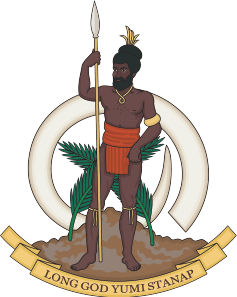The Efate bases
Bauer Field
On April 8 1942, around 500 men from the 4th Defence Battalion, 45th Marines, arrived on Efate to begin construction of an airfield. Around a month later, the 3rd Naval Construction Detachment, made up of Companies C and D of the 1st Construction Battalion, landed at Efate on May 4, to assist with the construction. When the Seabees arrived on Efate they found that the Marines had already cleared and surfaced approximately 2,000 feet (610 metres) of a 200 foot (61 metre) wide runway near Vila using coral as a surfacing material. Construction was immediately assumed by the Seabees, who cleared, grubbed, and graded a 6,000 foot (1828 metre) by 350 foot (106 metre) wide runway.




Remarkable for its sheer size, what was even more astounding was even after the Seabees pooled their resources with the Army and Marines, the total equipment included one crane, ten trucks, two motor patrol graders, one pull-type grader, seven bulldozers of various sizes, and one scarifier. What’s more, labour was in short supply and the conditions of jungle operations were hot, humid and at times tropically wet. It was an astounding achievement that the first aircraft landed on the field on May 28.
Of course the key reason behind the short deadline was to get bombers in the air as fast as possible to prevent the Japanese from building a similar airfield on Guadalcanal, from which they would be able to attack Allied supply lines across the South Pacific.
The airfield was originally named Efate Field, Vila Field or McDonald Field but was later officially named Bauer Field after Lt-Col. Harold W. Bauer, a fighter pilot in the US Marine Corps who was lost at sea on 14 November 1942 after being shot down during the Battle of Guadalcanal.

Seaplane Base
A detachment of Seabees also went north to Havannah Harbour to construct a seaplane base to serve the squadron of PBY Catalina’s based there. The Seabees built two seaplane ramps, once again of coral, surfaced with Marsden Matting, and provided buoys for mooring 14 seaplanes. In addition to the ramps and moorings, two small piers, two nose hangars, one 40 feet (12 metres) by 100 feet (30 metres) seaplane workshop, four 5,000 gallon (19,000 litre) underground gasoline tanks, and housing facilities for 25 officers and 210 men in quonset huts were constructed. By June 1, the PBYs began operating from the new base, bombing Japanese positions on Guadalcanal.
Havannah Harbour Field
In late 1942 the Seabees constructed a 3,000 foot (914 metre) by 180 foot (55 metre) fighter airstrip at Port Havannah. Fighters were able to land 26 days after construction began, and 15 days later the field was completed.
Quoin Hill Field
Quoin Hill, on the northeastern corner of the island a site was chosen for a bomber strip in an area of hot springs. The work on the 6,000 foot (1829 metre) by 200 foot (61 metre) runway was begun early in October and was completed by the middle of January 1943. Bombers took off from Efate within a month of the start of construction to harass the Japanese. But it soon became clear that Efate was not quite close enough to Guadalcanal for fighters to be able to provide fighter support to the bombers. That’s where Santo came into the picture.
Bombers took off from Efate within a month of the start of construction to harass the Japanese. But it soon became clear that Efate was not quite close enough to Guadalcanal for fighters to be able to provide fighter support to the bombers. That’s where Santo came into the picture.




